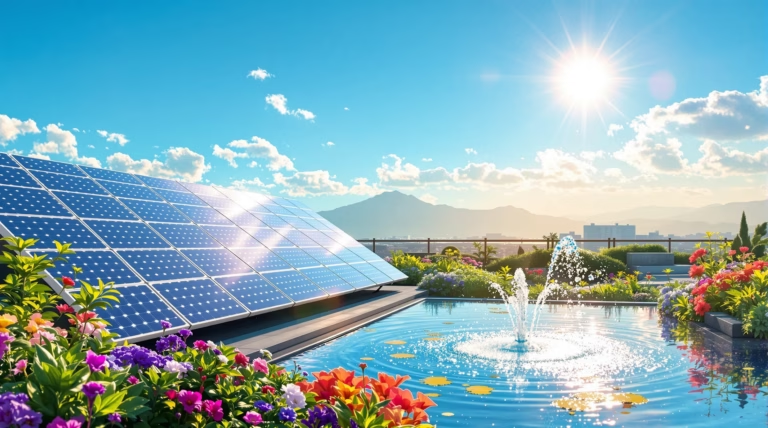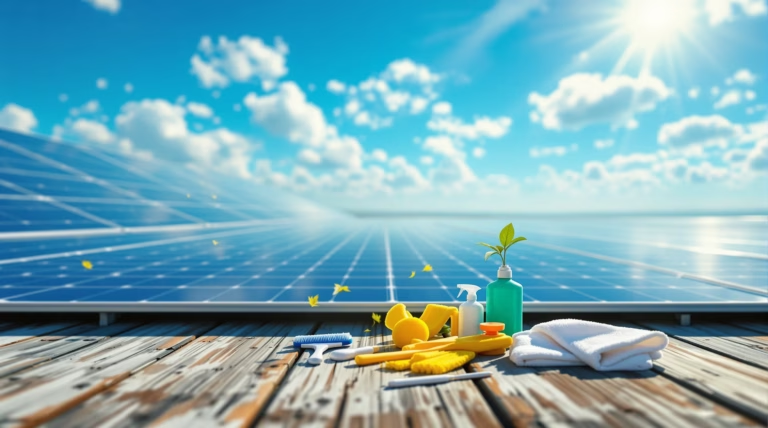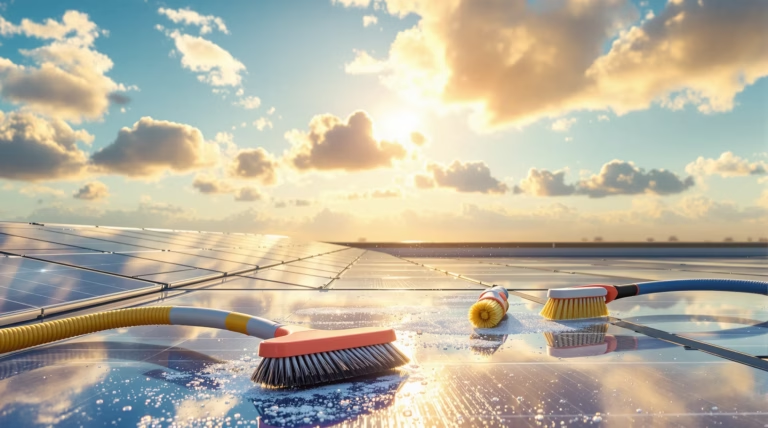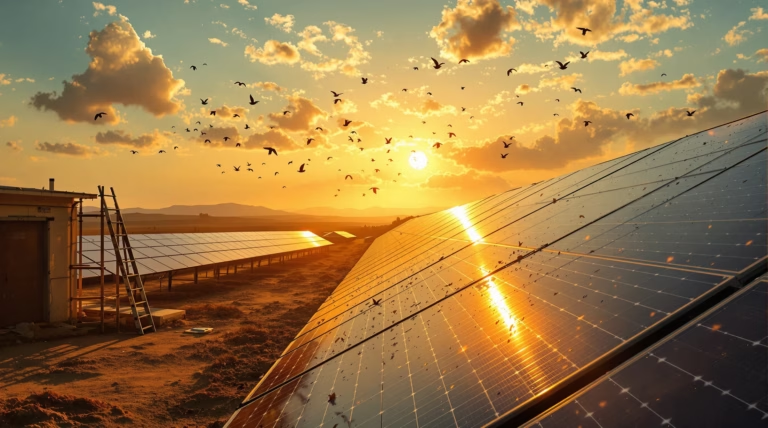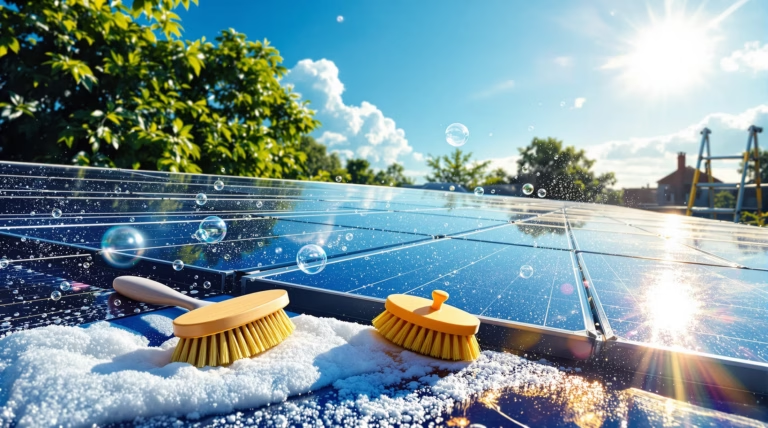How Do You Clean Solar Panels: A Complete Guide
Maintaining your solar panels’ efficiency is crucial for maximizing your renewable energy investment. Let’s explore the essential aspects of solar panel cleaning to help you protect and optimize your system’s performance.
Why Cleaning Solar Panels is Essential
Solar panel efficiency can decrease by up to 7% annually in most parts of the United States due to soiling – the accumulation of dirt, dust, bird droppings, and pollen. In dustier regions like the Middle East, these losses can reach up to 50%. Regular cleaning not only maintains optimal power generation but also extends your panels’ lifespan and ensures warranty validity.
Impact of Dirt and Debris on Solar Panel Efficiency
- Energy generation capacity can decrease by up to 30% due to dirt accumulation
- Efficiency improvements of up to 25% have been reported after initial cleaning
- Agricultural areas and high pollen regions experience more severe efficiency impacts
- Bird droppings create complete sunlight blockages
- Long-term dirt buildup can cause physical damage requiring costly repairs
How Often Should You Clean Your Solar Panels?
| Environment Type | Recommended Cleaning Frequency |
|---|---|
| Standard conditions | 1-2 times per year |
| Heavy dust/pollen areas | Quarterly |
| Rainy regions | As needed (natural cleaning) |
| High bird activity areas | Every 3-4 months |
Tools and Materials Needed for Cleaning Solar Panels
Using appropriate cleaning tools is essential for maintaining your panels without causing damage. Most cleaning supplies are readily available and affordable, but always consult your manufacturer’s manual for specific recommendations.
Recommended Cleaning Tools and Products
- Soft bristle brush with extendable handle
- Garden hose with spray nozzle
- Squeegee with soft rubber blade
- Lint-free microfiber cloths
- Mild dish soap or vinegar solution (2 cups deionized water + ¼ cup vinegar)
- Deionized or distilled water for rinsing
Avoiding Harmful Cleaning Agents
To protect your solar panels, avoid these harmful cleaning materials:
- Ammonia-based window cleaners
- Bleach and strong solvents
- Abrasive powders and scouring pads
- Hard water (high mineral content)
- Strong chemical cleaners
- Acetone-based products
Step-by-Step Guide to Cleaning Solar Panels
Safety should be your primary concern when cleaning solar panels. Turn off your system before beginning and work during early morning or evening hours when panels are cool. Following manufacturer-specified cleaning requirements is crucial for maintaining warranty coverage.
Step-by-Step Guide to Cleaning Solar Panels
Preparing for the Cleaning Process
- Review manufacturer’s guidelines for specific cleaning recommendations
- Power down the system according to safety protocols
- Choose optimal cleaning time – early morning or evening when panels are cool
- Gather essential supplies:
- Bucket with clean water and mild soap
- Soft-bristle brush with extendable handle
- Garden hose with gentle spray nozzle
- Soft microfiber cloths
- Assess panel accessibility and consider professional help for high or steep roofs
Cleaning Techniques for Optimal Results
- Begin with a gentle rinse using a hose to remove loose debris
- Apply soapy water solution using a soft-bristle brush in circular motions
- Focus on stubborn areas with dirt or bird droppings
- Use softened, distilled, or deionized water to prevent mineral deposits
- Thoroughly rinse panels with clean water to remove all soap residue
- Remove excess water with a squeegee, working top to bottom
- For accessible panels, finish with a lint-free microfiber cloth for streak-free results
Safety Precautions When Cleaning Solar Panels
Safety is paramount when maintaining solar panels. Falls from heights constitute a significant risk during cleaning, particularly with roof-mounted systems. Professional cleaning services are recommended for installations requiring ladder use or roof access.
Using Safety Gear and Equipment
- Essential safety equipment:
- Safety harness with secure anchoring
- Hard hat for head protection
- Non-slip, rubber-soled shoes
- Extension tools for ground-level cleaning
- Ladder safety guidelines:
- Place on stable, level ground
- Extend three feet above roof edge
- Follow 4-to-1 positioning rule
- Always have a spotter present
Avoiding Common Hazards
- Weather-related precautions:
- Avoid cleaning during electrical storms
- Skip high-wind conditions
- Clean during cool temperature periods
- Equipment safety:
- Never use pressure washers
- Maintain safe distance from power lines
- Ensure system is properly shut down
- Remove edge debris to prevent water pooling
When to Consider Professional Solar Panel Cleaning
Professional cleaning services are advisable for complex installations or challenging environmental conditions. These experts bring specialized equipment and safety measures that ensure optimal cleaning results without risking damage to your solar investment.
| Condition | Professional Cleaning Recommended |
|---|---|
| Coastal areas with salt spray | Yes |
| Urban areas with industrial residue | Yes |
| Properties near deciduous trees | Yes |
| Post-storm inspection and cleaning | Yes |
When to Consider Professional Solar Panel Cleaning
Benefits of Professional Cleaning Services
- Enhanced safety:
- Professional-grade harnesses and stabilizing equipment
- Specialized training for rooftop work
- Comprehensive insurance coverage
- Superior cleaning results:
- Purified water systems preventing mineral deposits
- Specialized soft brushes for solar panel glass
- Pre and post-cleaning efficiency testing
- Regular maintenance plans available
Cost vs. Benefit Analysis
| Cost Factors | Value Considerations |
|---|---|
| $100-$300 per service | 3-5% increase in electricity production |
| System size and accessibility | Annual energy savings potential |
| Roof pitch complexity | Extended system longevity |
| Location and travel costs | Reduced maintenance risks |
For ground-mounted systems, professional cleaning may not be cost-effective as owners can safely maintain them. However, rooftop installations often benefit from professional services, particularly when efficiency decreases noticeably. Consider professional cleaning annually or bi-annually, supplemented with simple hose rinses between services.
Factors Affecting Solar Panel Cleaning Frequency
The optimal cleaning schedule varies significantly based on installation specifics and environmental conditions. While some systems require monthly attention, others may need only annual maintenance, depending on local factors and panel positioning.
Environmental and Climatic Considerations
- Weather patterns:
- Regular rainfall provides natural cleaning
- Light rain can create stubborn mud deposits
- Seasonal challenges (pollen, falling leaves)
- Environmental conditions:
- Dust storms and wildfire smoke exposure
- High pollution levels in urban areas
- Coastal salt spray accumulation
Location-Specific Cleaning Needs
- Installation type impacts:
- Ground-mounted systems – easier access but more dust exposure
- Roof-mounted panels – varied debris from surrounding features
- Panel angle affecting natural runoff
- Urban vs. rural environmental factors
Monitor your system’s energy production metrics to identify when cleaning becomes necessary – significant efficiency decline often indicates maintenance is due, regardless of the time elapsed since the last cleaning.


